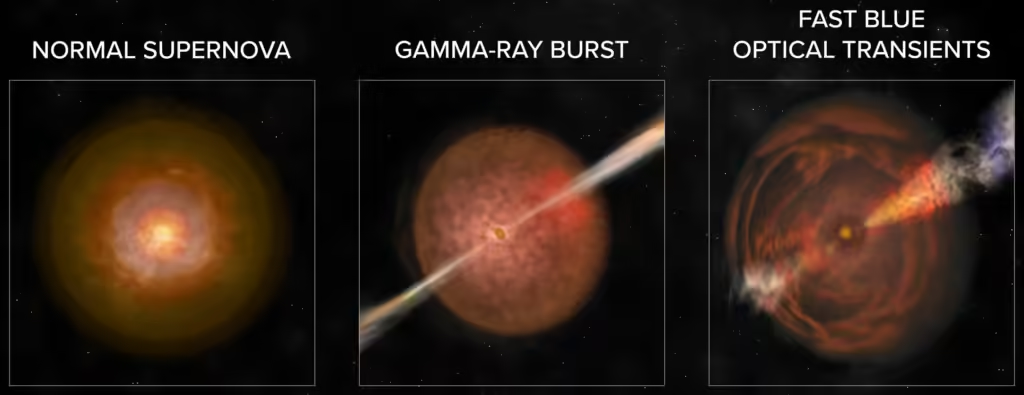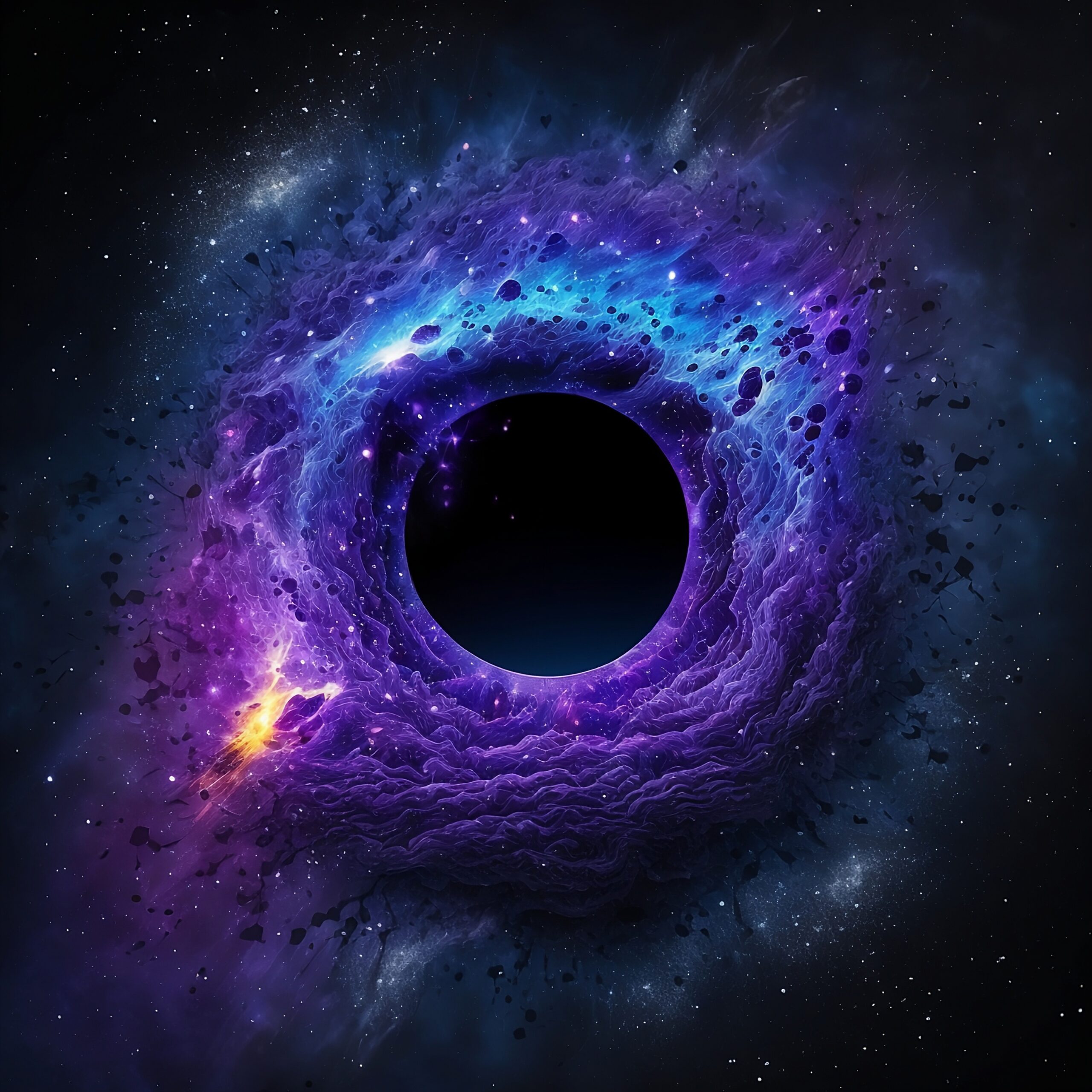Introduction
Gamma-ray bursts (GRBs) are some of the most powerful and dramatic events in the universe. In just a few seconds, they release more energy than our Sun will produce in its entire 10-billion-year life. These intense explosions of gamma radiation, often from billions of light-years away, are so strong that we can detect them from incredibly far distances across space.
There are two types of gamma-ray bursts (GRBs): short bursts, which likely happen when two neutron stars collide, and long bursts, which are caused by the collapse of massive stars into black holes. In just a split second, a GRB can release more energy than all the stars in a galaxy combined. These bursts create afterglows of X-rays, visible light, and radio waves, which astronomers use to learn more about the farthest parts of the universe.
GRBs are incredibly powerful, making them important for understanding extreme events in space, like how black holes form and how the universe expands. Even though they usually happen far away, a nearby GRB could have devastating effects on Earth, such as destroying our atmosphere and causing mass extinctions. By studying GRBs, scientists can better understand both the violent forces in the universe and the fragile conditions that make life on Earth possible.
What are Gamma Ray Bursts?
Gamma-ray bursts (GRBs) are short and powerful flashes of gamma radiation. They are known for their bright light and high energy. These bursts usually come from faraway galaxies and help scientists learn about some of the universe’s most intense events. Here’s a closer look:
Characteristics:
Duration and Intensity: Gamma-ray bursts (GRBs) can last anywhere from milliseconds to several minutes. The most intense bursts release energy equal to that of hundreds of thousands of supernovae. The gamma rays produced during these bursts are the highest-energy type of electromagnetic radiation.
- Long-Duration GRBs: These bursts last over two seconds and are linked to the deaths of massive stars that are more than 30 times the mass of the Sun. When the core of one of these stars collapses into a black hole, it can create a jet of material that emits gamma rays.
- Short-Duration GRBs: These bursts last less than two seconds and are believed to occur when compact objects, like neutron stars or black holes, merge. These collisions produce highly energetic jets that release gamma radiation.
Afterglows: After the initial gamma-ray burst, GRBs create afterglows that can be detected in X-ray, optical, and radio wavelengths. These afterglows can last from hours to weeks and are important for helping scientists understand the burst’s distance, composition, and the environment around it.
Distance and Cosmological Importance: GRBs are usually located in distant galaxies, often billions of light-years away. Their incredible brightness enables astronomers to study the early universe, offering important insights into how galaxies form and evolve.

Page URL: https://commons.wikimedia.org/wiki/
Attribution: Bill Saxton, NRAO/AUI/NSFhttps://public.nrao.edu/blogs/author/billsaxton/, CC BY-SA 3.0 https://creativecommons.org/licenses/by-sa/3.0, via Wikimedia Commons
Significance:
Astrophysical Laboratories: GRBs act as natural laboratories for studying extreme physics. They help scientists understand how matter behaves under high-energy conditions, how black holes form, and how relativistic jets operate.
Cosmological Probes: GRBs can measure cosmic distances, making them important for cosmology. They help scientists improve their understanding of the universe’s expansion and how matter is distributed throughout it.
Potential Threats: Even though GRBs usually happen far away, a nearby event (within a few thousand light-years) could be disastrous for Earth. It could lead to the depletion of the ozone layer and increased radiation exposure.
What Causes Gamma Ray Bursts?
Gamma-ray bursts (GRBs) are some of the most energetic and mysterious events in the universe. Their causes can be grouped into two main types: short GRBs and long GRBs. Each type is connected to different astrophysical processes, mainly related to the violent deaths of stars or the merging of compact stellar remnants. Here’s a closer look at what causes both short and long GRBs:
Massive Star Collapse (Supernova/Hypernova):
Long gamma-ray bursts (GRBs) are usually linked to the collapse of massive stars that are more than about 30 times the mass of the Sun at the end of their life cycles. When these stars run out of nuclear fuel, they can no longer support themselves against gravitational collapse. As a result, the core collapses into a black hole, while the outer layers may explode as a supernova or hypernova. This process creates a relativistic jet, and when this jet breaks through the star’s surface, it emits a powerful burst of gamma rays that can last from a few seconds to several minutes.

Page URL: https://commons.wikimedia.org/wiki/
Attribution: International Gemini Observatory/NOIRLab/NSF/AURA/J. Pollard/K. Paterson & W. Fong (Northwestern University). Image processing: Travis Rector (University of Alaska Anchorage), Mahdi Zamani & Davide de Martin, CC BY 4.0 https://creativecommons.org/licenses/by/4.0, via Wikimedia Commons
The Role of Black Holes:
Black hole formation is a key part of both short and long gamma-ray bursts (GRBs). In long GRBs, the core of a collapsing massive star turns into a black hole, which can generate jets that emit gamma rays. In short GRBs, when neutron stars or a neutron star and a black hole merge, they often create a black hole as well. This process can significantly increase the energy released during the explosion.
Conclusion
Studying gamma-ray bursts (GRBs) is essential for advancing our understanding of the universe. They serve as powerful tools for exploring extreme astrophysical processes, such as the formation of black holes and the behavior of matter under high-energy conditions. GRBs also act as cosmological probes, helping scientists measure cosmic distances and refine our knowledge of the universe’s expansion and the distribution of matter. Additionally, they provide insights into the early universe and galaxy formation. Overall, GRBs are crucial for deepening our understanding of the cosmos and the fundamental forces at play in it.
Share the knowledge with

